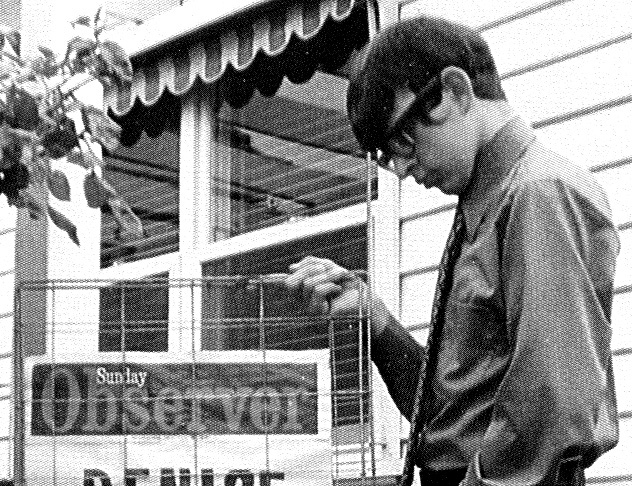
Origins of the Observer, Nation Review
Local Media Pty Ltd, current-day publisher of the Melbourne Observer and The Local Paper network, can trace its beginnings to the first days of the Sunday Observer and Nation Review newspapers.
The Sunday Observer newspaper was established in Melbourne by businessman Gordon Barton (IPEC) on September 14, 1969. The Sunday Review (later The Review and then Nation Review) first hit the streets on October 11, 1970. Local Media Pty Ltd publisher Ash Long was there at the very beginning.
Long (aged 12 in 1969) started as a Sunday Observer newsboy in late September 1969, and his family took on a distribution agency in the northern suburbs in that first year. The Sunday Observer distribution work continued under Barton’s proprietorship, lasting until that masthead’s closure in March 1971. Later, the job involved picking up Sunday Review newspapers from the Fishermens Bend printery and delivering bundles to retail outlets and milk bars, first on a Saturday night-Sunday morning, then on a Friday night, and then on a Thursday night. As a teenage schoolboy, Ash worked overnight as a ‘jockey’ as his father Jim drove the family Holden EJ station wagon and trailer to outlets around the suburbs. Ash’s brother, Greg, then a law student, had further distribution rounds covering the north-west and south-eastern suburbs, as well as the University of Melbourne and La Trobe University.
Later Review printeries included S&G Rotary Printery (also at Fishermens Bend), Stockland Press in North Melbourne, Progress Press in Burwood and Moorabbin, and Waverley Offset Printers. This was a complete unofficial apprenticeship for a curious and keen teenager, eager to learn every aspect of newspapers. Ash Long worked on newspaper presses as a labourer, used his brain to plan distribution runs (logistics), and learn all aspects of offset pre-press (production).
The Longs also had an extra delivery round to Essendon Aerodrome to load newspaper bundles into the waiting Brain and Brown DC-3 aircraft bound for Tasmania, and then out to the newly-opened TAA freight centre at Tullamarine Airport to dispatch newspapers to every other state, and Papua-New Guinea. With the overnight newspaper work done, Ash Long would go off to secondary school for a full day’s learning.
Barton’s distribution company was known as Incorporated Newsagencies Company Pty Ltd, pitched against the official ‘Victorian Associated Newsagents Association’. As time progressed, Barton tried to expand the distribution network by adding other publications which included Harry Beitzel’s Footy Week, (free), Piotr Olzewski’s Rats (45 cents per copy), Popular Motorcycling (20 cents per copy), Labor 73 (10 cents cover price), Lumiere, Cobber Comix (40 cents), Rolling Stone (60 cents) and The Digger (30 cents).
In 1971, Harry Beitzel’s Footy Week was distributed to outlets (including Caltex service stations) on a Sunday morning. This was an era when all six Victorian Football League matches were played on Melbourne suburnan grounds on Saturday afternoons. On August 1, the paper converted to Sunday Sport (10 cents per copy), which also covered racing and other sports.
Beitzel’s right-hand man, Ray Young, wrote: “it is Harry Beitzel’s wish that all supervisors emply at least six to eight boys for sales of major intersections in their area.” Within less than half-a-dozen weeks, Sunday News had switched to VANA sub-agents only, adopting a lower 10-cent cover price.
On September 24, 1971, a memo exposed friction between INC and Harry Beitzel: “Some distributors have decided not to proceed in the distribution of the [Sunday News] publication for Mr Beitzel. We have been approached today to see whether we would agree to those agents not proceeding with Beitzel to take his man around their area to ensure that all outlets are covered. This request was denied. The situation as The Review sees it is simply this: a lot of your time and the Review’s money has been put into arranging the Review’s distribution system. Mr Beitzel has decided not to proceed with his arrangement with the Review and has subsequently engaged several Review distributors and other persons to handle Sunday News distribution – receiving the benefit of your time and our money at no cost to himself for the initial preparation work. The Review does not consider it should hand its distribution system for gratis to another publisher who has rescinded his arrangement with us. For the third week in succession you are therefore requested not to make your list of Review outlets available to any other parties. Thanks fellas.”
Sunday News lasted just 26 weeks, with Beitzel amassing a loss of more than $200,000.
The Review consolidated by incorporating Nation magazine (1958-1972), previously published by Tom Fitzgerald and edited by George Munster.
The Digger circularised retailers that it was a youth-orented broadsheet, “managed by the team who built Go-Set to a peak 64,000 sales.. “It will report more than the world of rock music – special Digger correspondents will write on women’s liberation, trade union news, university politics, and sport,” noted Terrence Cleary, Circulation Manager.
In August 1971, The Review doubled its cover price overnight, issuing a tongue-in-cheek point-of-sale poster – ‘One For The Price of Two’. It took a temporary sales hit, but the overall momentum for the year was up. Melbourne distributors were required to phone the Review’s Jenny Harrison each week to advise quantities required. A letter to distributors said: “The proprietors of our publishing company have been greatly concerned about our ability to absorb rising costs in producing the Review and have rightly questioned the future viability of our operation. With reluctance, we have been obliged to increase the retail price of the Review to 30 cents each, starting from the issue you collect tonight. We expect to lose sales as a result of this move, of course. We seek your earnest help in minimising this sales loss.”
The Sunday Observer had closed as a Barton production five months earlier in March 1971. An August 20, 1971 memo noted: “The Barndana operation at Fishermen’s Bend has completely ceased and all the equipment, including the press, will be auctioned next Thursday. Tomorrow the Review moves to 113 Rosslyn St, West Melbourne. We will be in our own building – an indication of our confidence of the Review’s future.” The departure of distribution man, Mario Sartori, was noted.
Sometimes controversial Nation Review covers would cause unrest amongst retailers who needed coaxing to display the paper. They were circularised: “At times you may have some reservations about displaying the Review because of its cover illustration or lead story. We have a highly developed understanding of our readers’ needs, so we ask that the Review stays on display, even if you fold it or form a fan with several copies to disguise it for more sensitive customers.”
Rolling Stone’s retail price was 60 cents, with 15 cents commission per sold copy for the distributors. It was published fortnightly. Over a nine-week period, Greg Long noted that his Digger rounds issued an aggregate of 2031 copies, with 1064 returns, making 967 sales.
The lead-up to the 1972 Federal Election saw an optimism by the publishers: “As Nation Review gains in sales and advertising support, we have increased our print run and our number of pages printed. Coupling these facts with the imminent price increase for newsprint, we are obliged to critically analyse the situation to find ways to control expenditure.” Barry Watts noted that the interstate professional distributors had contained unsold copies to 12 per cent-18 per cent.
The conversion to a Thursday night print slot commenced in the pre-Christmas publishing period of 1972, just after Gough Whitlam’s election. Nation Review Business Manager Barry Watts wrote to distributors: “We have been gratified with the consistent sales of the Review during the first portion of the holiday period, and apportion a large portion of this to our Thursday evening print time. As a result, it hjas been decided to print on Thursday evenings for each issue in both January and February … in order to maximise sales – and to protect your own part-time income – it is important that you effect delivery of your Reviews in time for them to go on sale by 8am each Friday during the next two months.
In August 1973, Barry Watts advised that accountant Andrew King would take responsibility for local and national distribution, whilst Watts went on to spend more time developiing the counter-culture newspaper, The Living Daylights, to be edited by Richard Neville of Oz fame, and to be distributed through the VANA system, by David Syme & Co. Ltd (The Age). In October, King, circularised the distribution contractors: “The alternative distribution arrangements made by The Digger and Rolling Stone have fallen through. We have agreed to distribute one more issue of each of these publications.”
By October 22, 1973, King wrote: “We wish to advise that this company has decided to close down its current distribution system. From the next issue of Nation Review, distribution of our publications in Victoria will be handled by authorised newsagents only. We wish to thank you for your efforts over the years in promotinbg the sales of publications distributed by this company.” King noted: “The decision to go through the VANA system has been prompted by our belief that this system is economically more viable, and this, together with the other benefits that will accrue from the VANA system will facilitate the continued growth of our publications.”
